《学前教育专业英语》第三章
- 格式:pptx
- 大小:11.85 MB
- 文档页数:84
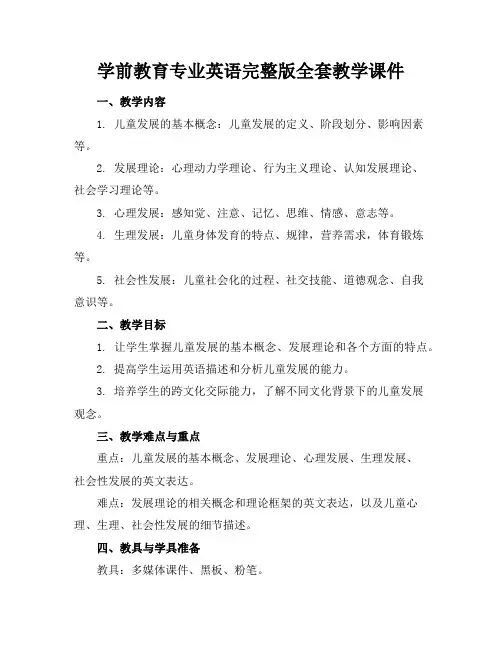
学前教育专业英语完整版全套教学课件一、教学内容1. 儿童发展的基本概念:儿童发展的定义、阶段划分、影响因素等。
2. 发展理论:心理动力学理论、行为主义理论、认知发展理论、社会学习理论等。
3. 心理发展:感知觉、注意、记忆、思维、情感、意志等。
4. 生理发展:儿童身体发育的特点、规律,营养需求,体育锻炼等。
5. 社会性发展:儿童社会化的过程、社交技能、道德观念、自我意识等。
二、教学目标1. 让学生掌握儿童发展的基本概念、发展理论和各个方面的特点。
2. 提高学生运用英语描述和分析儿童发展的能力。
3. 培养学生的跨文化交际能力,了解不同文化背景下的儿童发展观念。
三、教学难点与重点重点:儿童发展的基本概念、发展理论、心理发展、生理发展、社会性发展的英文表达。
难点:发展理论的相关概念和理论框架的英文表达,以及儿童心理、生理、社会性发展的细节描述。
四、教具与学具准备教具:多媒体课件、黑板、粉笔。
学具:教材、笔记本、文具。
五、教学过程1. 导入:通过展示儿童发展的图片,引导学生思考儿童发展的重要性,激发学习兴趣。
2. 讲解:分别讲解儿童发展的基本概念、发展理论、心理发展、生理发展、社会性发展的英文表达,并结合实例进行说明。
3. 讨论:分组讨论儿童发展的各个方面,让学生运用所学知识进行分析。
4. 练习:布置随堂练习,让学生运用所学知识进行答题。
6. 拓展:引导学生关注不同文化背景下的儿童发展观念,提高跨文化交际能力。
六、板书设计板书内容:儿童发展基本概念、发展理论、心理发展、生理发展、社会性发展。
板书结构: + 关键词 + 简要解释 + 实例。
七、作业设计1. 作业题目:请用英语写一篇关于儿童发展的短文,包括儿童发展的基本概念、发展理论、心理发展、生理发展、社会性发展等方面的内容。
2. 答案:Children's development refers to the process of physical, cognitive, emotional, and social changes that occur inchildren as they grow from infancy to adulthood. It isinfluenced genetic factors, environmental factors, and individual experiences.There are several theories of child development that explain how children grow and develop. The psychodynamic theory proposed Sigmund Freud emphasizes the role of unconscious desires and conflicts in shaping a child's personality. The behaviorist theory, represented B.F. Skinner, focuses on the role of environmental stimuli and reinforcement in learning and behavior. The cognitive development theory, developed Jean Piaget, explains how children's thinking and understanding develop through stages. The social learning theory, proposed Albert Bandura, emphasizes the importance of observational learning and modeling in the development of social behavior.八、课后反思及拓展延伸本节课通过讲解和讨论,使学生对儿童发展的基本概念、发展理论和各个方面有了更深入的了解。
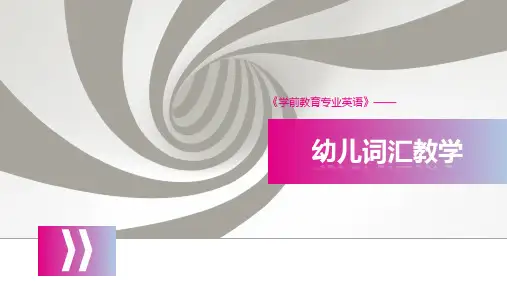
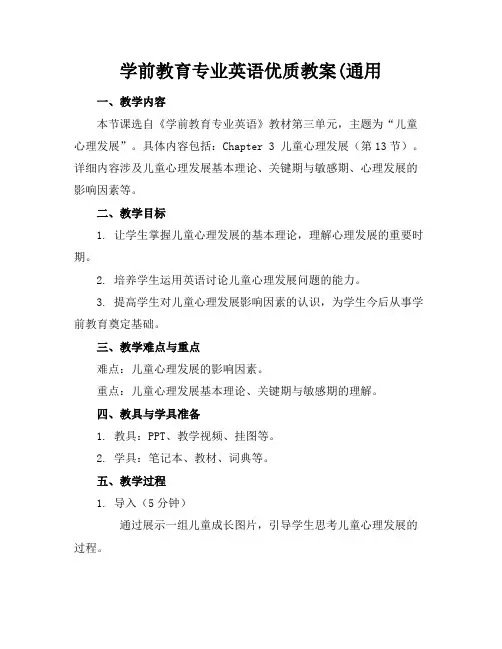
学前教育专业英语优质教案(通用一、教学内容本节课选自《学前教育专业英语》教材第三单元,主题为“儿童心理发展”。
具体内容包括:Chapter 3 儿童心理发展(第13节)。
详细内容涉及儿童心理发展基本理论、关键期与敏感期、心理发展的影响因素等。
二、教学目标1. 让学生掌握儿童心理发展的基本理论,理解心理发展的重要时期。
2. 培养学生运用英语讨论儿童心理发展问题的能力。
3. 提高学生对儿童心理发展影响因素的认识,为学生今后从事学前教育奠定基础。
三、教学难点与重点难点:儿童心理发展的影响因素。
重点:儿童心理发展基本理论、关键期与敏感期的理解。
四、教具与学具准备1. 教具:PPT、教学视频、挂图等。
2. 学具:笔记本、教材、词典等。
五、教学过程1. 导入(5分钟)通过展示一组儿童成长图片,引导学生思考儿童心理发展的过程。
提问学生:“What do you think is the most important period for a child's psychological development?”2. 理论学习(15分钟)讲解儿童心理发展的基本理论,如皮亚杰、维果茨基等人的理论。
介绍关键期与敏感期,以及它们在儿童心理发展中的作用。
3. 实践情景引入(10分钟)播放一段关于儿童心理发展关键期的教学视频。
让学生分组讨论,结合视频内容,探讨关键期对儿童心理发展的影响。
4. 例题讲解(10分钟)出示一道关于儿童心理发展的选择题,引导学生运用所学知识进行分析。
讲解答案,解析解题思路。
5. 随堂练习(10分钟)让学生完成教材第3章的练习题,巩固所学知识。
答疑解惑,针对学生练习中的问题进行解答。
回顾本节课所学内容,强调重点知识。
提醒学生关注儿童心理发展的影响因素。
六、板书设计1. 儿童心理发展2. 内容:儿童心理发展基本理论关键期与敏感期儿童心理发展的影响因素七、作业设计1. 作业题目:请简述皮亚杰和维果茨基的儿童心理发展理论。
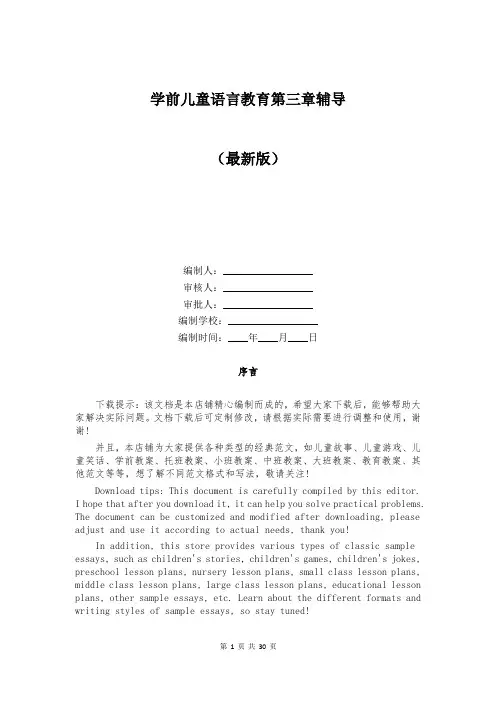
学前儿童语言教育第三章辅导(最新版)编制人:__________________审核人:__________________审批人:__________________编制学校:__________________编制时间:____年____月____日序言下载提示:该文档是本店铺精心编制而成的,希望大家下载后,能够帮助大家解决实际问题。
文档下载后可定制修改,请根据实际需要进行调整和使用,谢谢!并且,本店铺为大家提供各种类型的经典范文,如儿童故事、儿童游戏、儿童笑话、学前教案、托班教案、小班教案、中班教案、大班教案、教育教案、其他范文等等,想了解不同范文格式和写法,敬请关注!Download tips: This document is carefully compiled by this editor.I hope that after you download it, it can help you solve practical problems. The document can be customized and modified after downloading, please adjust and use it according to actual needs, thank you!In addition, this store provides various types of classic sample essays, such as children's stories, children's games, children's jokes, preschool lesson plans, nursery lesson plans, small class lesson plans, middle class lesson plans, large class lesson plans, educational lesson plans, other sample essays, etc. Learn about the different formats and writing styles of sample essays, so stay tuned!学前儿童语言教育第三章辅导学前儿童语言教育第三章辅导第三章幼儿园语言教育的目标、内容、方法和途径第一节幼儿园语言教育的目标一、幼儿园语言教育的总目标教育部颁布的《幼儿园教育指导纲要(试行)》中对语言领域提出了以下目标:第一,乐意与人交谈,讲话礼貌;第二,注意倾听对方讲话,能理解日常用语;第三,能清楚地说出自己想说的事;第四,喜欢听故事、看图书;第五,能听懂和会说普通话。
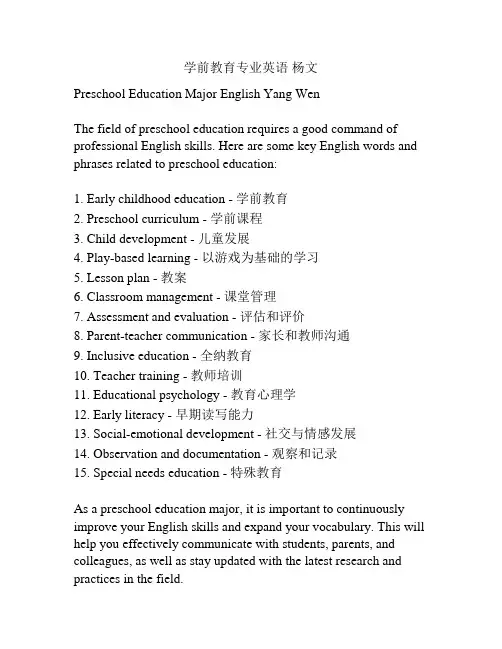
学前教育专业英语杨文Preschool Education Major English Yang WenThe field of preschool education requires a good command of professional English skills. Here are some key English words and phrases related to preschool education:1. Early childhood education - 学前教育2. Preschool curriculum - 学前课程3. Child development - 儿童发展4. Play-based learning - 以游戏为基础的学习5. Lesson plan - 教案6. Classroom management - 课堂管理7. Assessment and evaluation - 评估和评价8. Parent-teacher communication - 家长和教师沟通9. Inclusive education - 全纳教育10. Teacher training - 教师培训11. Educational psychology - 教育心理学12. Early literacy - 早期读写能力13. Social-emotional development - 社交与情感发展14. Observation and documentation - 观察和记录15. Special needs education - 特殊教育As a preschool education major, it is important to continuously improve your English skills and expand your vocabulary. This will help you effectively communicate with students, parents, and colleagues, as well as stay updated with the latest research and practices in the field.。
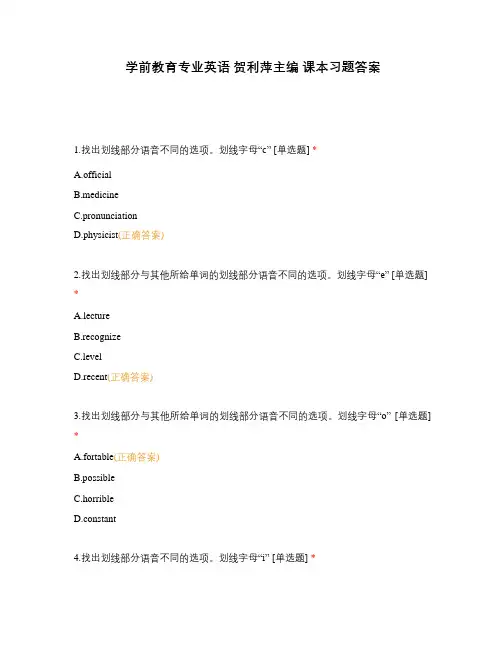
学前教育专业英语贺利萍主编课本习题答案1.找出划线部分语音不同的选项。
划线字母“c” [单选题] *A.officialB.medicineC.pronunciationD.physicist(正确答案)2.找出划线部分与其他所给单词的划线部分语音不同的选项。
划线字母“e” [单选题] *A.lectureB.recognizeC.levelD.recent(正确答案)3.找出划线部分与其他所给单词的划线部分语音不同的选项。
划线字母“o”[单选题] *A.fortable(正确答案)B.possibleC.horribleD.constant4.找出划线部分语音不同的选项。
划线字母“i” [单选题] *A.climbB.mindC.signD.print(正确答案)5.找出划线部分与其他所给单词的划线部分语音不同的选项。
划线字母“ea” [单选题] *A.measureB.healthC.theatre(正确答案)D.ready6.单项选择—What _____ are you taking this term?—We are taking maths, English and computer. [单选题] *A.majorsB. skillsC. subjects(正确答案)D.sports7.—How far is it from your home to school?—About___________ walk. [单选题] *A.ten minuteB. ten minutes’(正确答案)C. ten minutesD. ten minute’s8.My parents are both very ______ with their work. They don’t have too much time to stay with me. [单选题] *A. busy(正确答案)B. kindC. carefulD. worried9.Alice hopes to _________ more friends at her new school. [单选题] *A. visitB. make(正确答案)C. missD. talk10. Amy usually ________ at 6:30 in the morning. [单选题] *A. goes to bedB. go to bedC. goes homeD. gets up(正确答案)11._________ is good for our health. [单选题] *A.Staying up lateB. Sleeping enough(正确答案)C. Getting up lateD. Eating12.Tom’s bag is blue, that black bag is _______. [单选题] *A.myB. herC. mine(正确答案)D.Lily’s and Lucy’s13.It’s expensive to ___________. [单选题] *A. take the busB. ride a bikeC. take a taxi(正确答案)D. take photos14. I like _________ best. All the clothes are made of newspapers. [单选题] *A. the fashion show(正确答案)B. the talk showC. the magic showD. pictures15. —What kinds of films do children like most?—____________, I think. [单选题] *A. Cartoons(正确答案)B. Horror filmC. Literary filmsD. Documentary16.My good friend Tom ______ going to the park on weekends. [单选题] *A. likedB. likeC. enjoys(正确答案)D. enjoy17.There _____ no water or milk in the fridge. [单选题] *A. is(正确答案)B. areC. hasD. have18. Would you like to take ____walk with me? [单选题] *A. anB. a(正确答案)C. theD. /19.We will go to New York _____ air ______ October. [单选题] *A. on; inB. by; in(正确答案)C. in; onD. on; on20.Of the three books, I like the ________ best. [单选题] *A. newerB. newest(正确答案)C. olderD. old21.Eric and Tom ________ have skill training in the school next month. [单选题] *A. are going to(正确答案)B. be going toC. is goingD. are going22. —__________ do you go to see a film?— Once a month. [单选题] *A. How longB. How muchC. How often(正确答案)D. How far23.If it rains tomorrow, we________ go to the park. [单选题] *A.willB. won’t(正确答案)C. areD.be going to24.My parents often ask me ________ more sports after school. [单选题] *A. doC. doesD. to do(正确答案)25.Be careful when you ________ the street. [单选题] *A.are crossing(正确答案)B. is crossingC. crossingD. is cross26.—Do you know ________ old lady in blue?—Yes,she is a teacher of ________ university in Beijing. [单选题] *A.a,anB.the,anC.the,a(正确答案)D.an,a27.Beth has a beautiful ________.Listen!She is singing beautifully. [单选题] *A. soundB.voice(正确答案)C.noiseD.Look28.The red bike ________be Hu's.Hers is blue. [单选题] *A.mustC.canD.can't(正确答案)29.I don't know if I______him this evening.If I_____ him,I will give the novel to him. [单选题] *A.will meet,will meetB.will meet,meet(正确答案)C.meet,will meetD.meet,meet30.—He’s never stolen anything before, _____he?—_______. It’s his third time to be taken to police station. [单选题] *A. hasn’t, YesB. is, YesC. has, Yes(正确答案)D. has, No31.—Lots of trees and flowers ________ on both sides of the road last year. —Oh, _______ beautiful they are! [单选题] *A. were planted; how(正确答案)B. were planted; whatC. have been planted; howD. have been planted; what32.I haven’t ____ you for a long time [单选题] *A. heard ofB. hear fromC. hear ofD. heard from(正确答案)33.— I saw Mr Smith in the office at ten yesterday morning. —That’s impossible. He ____ an English party with us then. [单选题] *A. hasB hadC was having(正确答案)D. has had34.I don’t know ______. [单选题] *A. what is wrong with him(正确答案)B. what the matter with himC. what wrong is with himD. what the matter to him35.—would you like to go shopping with me after school?—_______________, but I have many work to do. [单选题] *A.Yes, pleaseB. I’d like to(正确答案)C. Sorry, I can’tD. Never mindIII. 完形填空材料。
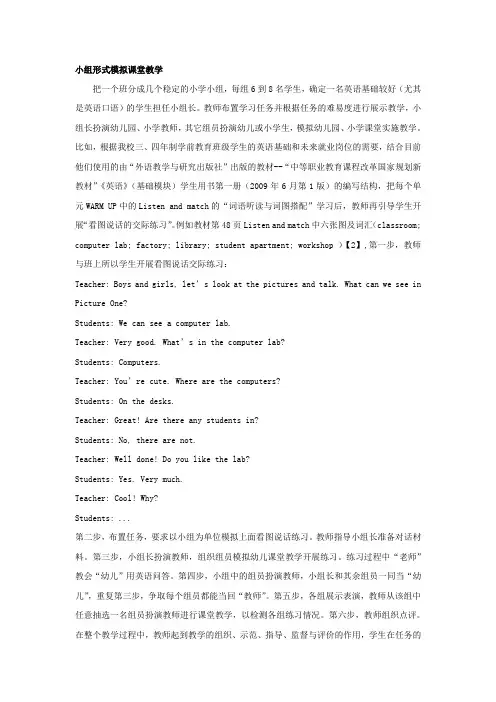
小组形式模拟课堂教学把一个班分成几个稳定的小学小组,每组6到8名学生,确定一名英语基础较好(尤其是英语口语)的学生担任小组长。
教师布置学习任务并根据任务的难易度进行展示教学,小组长扮演幼儿园、小学教师,其它组员扮演幼儿或小学生,模拟幼儿园、小学课堂实施教学。
比如,根据我校三、四年制学前教育班级学生的英语基础和未来就业岗位的需要,结合目前他们使用的由“外语教学与研究出版社”出版的教材--“中等职业教育课程改革国家规划新教材”《英语》(基础模块)学生用书第一册(2009年6月第1版)的编写结构,把每个单元WARM UP中的Listen and match的“词语听读与词图搭配”学习后,教师再引导学生开展“看图说话的交际练习”。
例如教材第48页Listen and match中六张图及词汇(classroom; computer lab; factory; library; student apartment; workshop )【2】,第一步,教师与班上所以学生开展看图说话交际练习:Teacher: Boys and girls, let’s look at the pictures and talk. What can we see in Picture One?Students: We can see a computer lab.Teacher: Very good. What’s in the computer lab?Students: Computers.Teacher: You’re cute. Where are the computers?Students: On the desks.Teacher: Great! Are there any students in?Students: No, there are not.Teacher: Well done! Do you like the lab?Students: Yes. Very much.Teacher: Cool! Why?Students: ...第二步,布置任务,要求以小组为单位模拟上面看图说话练习。
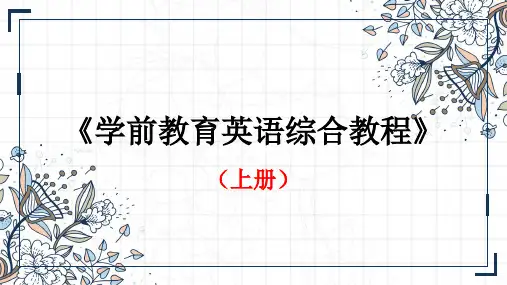
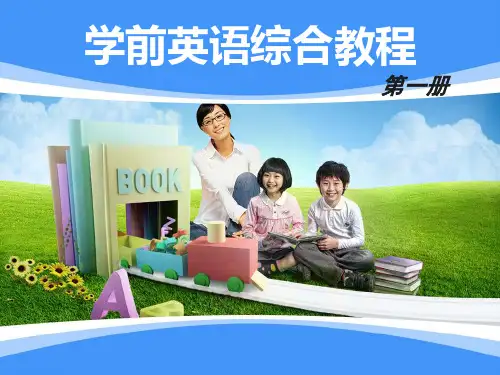
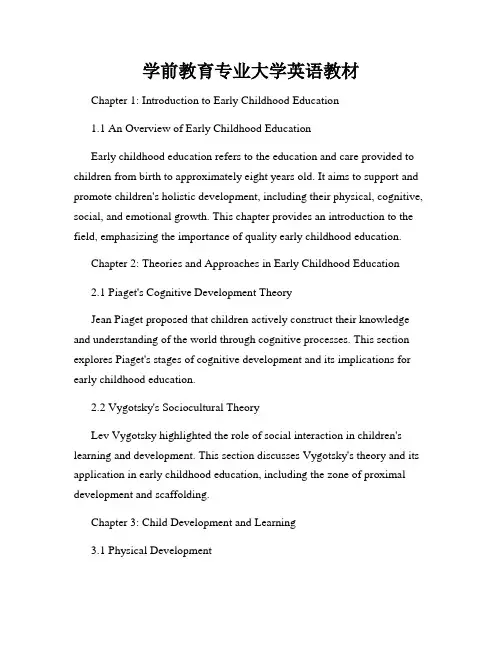
学前教育专业大学英语教材Chapter 1: Introduction to Early Childhood Education1.1 An Overview of Early Childhood EducationEarly childhood education refers to the education and care provided to children from birth to approximately eight years old. It aims to support and promote children's holistic development, including their physical, cognitive, social, and emotional growth. This chapter provides an introduction to the field, emphasizing the importance of quality early childhood education.Chapter 2: Theories and Approaches in Early Childhood Education2.1 Piaget's Cognitive Development TheoryJean Piaget proposed that children actively construct their knowledge and understanding of the world through cognitive processes. This section explores Piaget's stages of cognitive development and its implications for early childhood education.2.2 Vygotsky's Sociocultural TheoryLev Vygotsky highlighted the role of social interaction in children's learning and development. This section discusses Vygotsky's theory and its application in early childhood education, including the zone of proximal development and scaffolding.Chapter 3: Child Development and Learning3.1 Physical DevelopmentThis section focuses on children's physical development during the early years, including motor skills, coordination, and sensory development. It discusses the importance of providing a conducive environment for children to explore and develop their physical abilities.3.2 Cognitive DevelopmentChildren's cognitive development refers to the development of thinking, problem-solving, and memory skills. This section explores various aspects of cognitive development and suggests effective teaching strategies to enhance children's cognitive growth.3.3 Social and Emotional DevelopmentThe social and emotional development of children plays a crucial role in their overall well-being. This section examines the milestones and factors influencing social and emotional development, emphasizing the importance of creating a supportive and nurturing environment.Chapter 4: Curriculum and Instruction in Early Childhood Education4.1 Curriculum ModelsDifferent curriculum models, such as Montessori, Reggio Emilia, and High Scope, have emerged in early childhood education. This section explores these models, highlighting their principles, goals, and approaches to curriculum planning.4.2 Play-Based LearningPlay is an essential aspect of early childhood education. This section discusses the importance of play-based learning and offers practicalsuggestions for incorporating play into the curriculum to promote children's holistic development.Chapter 5: Assessment and Evaluation in Early Childhood Education5.1 Purpose of AssessmentAssessment in early childhood education serves multiple purposes, including monitoring children's progress, identifying individual needs, and informing instructional decisions. This section explores different assessment methods and their appropriate use in the early years.5.2 Observational AssessmentObservational assessment involves systematically observing and documenting children's behaviors, interactions, and learning experiences. This section provides guidance on conducting effective observational assessments and using the information gathered to inform teaching and learning.Chapter 6: Family and Community Engagement6.1 Importance of Family-Teacher PartnershipsFamily involvement and collaboration between teachers and families are essential for supporting children's learning and development. This section discusses effective strategies for building positive partnerships with families and engaging the community in early childhood education.Chapter 7: Inclusive Practices in Early Childhood Education7.1 Inclusion and DiversityInclusive practices aim to provide equitable learning opportunities for all children, regardless of their abilities or backgrounds. This section explores the principles of inclusive education and provides strategies for creating inclusive early childhood classrooms.Chapter 8: Professional Ethics and Development in Early Childhood Education8.1 Ethical Standards for Early Childhood EducatorsEarly childhood educators are responsible for upholding ethical standards in their professional practice. This section discusses the ethical dilemmas educators may encounter and provides guidance on ethical decision-making.8.2 Professional Development in Early Childhood EducationContinuing professional development is crucial for early childhood educators to enhance their knowledge, skills, and pedagogical practices. This section highlights the importance of ongoing professional development and explores various avenues for educators to engage in professional learning.ConclusionThe study of early childhood education is vital for individuals aspiring to work with young children. This textbook provides a comprehensive overview of the field, covering various aspects such as theories, child development, curriculum, assessment, family engagement, inclusive practices, and professional ethics. By studying this material, future educators will be equipped with the necessary knowledge and skills to provide high-quality education and care to young children.。

《学前教育专业英语》教学大纲课程开设学时:一学年,共64学时适用专业:学前教育专业一、课程的性质与目标《学前教育专业英语》是学前教育专业的专业基础课程。
通过本课程的学习,学生能够掌握基本的英语语言的发音、词汇以及语法规则,获得基本的英语口语交际和英文阅读能力;了解幼儿园英语教师的典型工作任务,掌握幼儿英语教学活动设计的一般方法,形成良好的基础知识和基本技能素养,为职业生涯、继续学习和终身发展奠定基础。
二、课程设计理念与思路课程设计理念:着眼于学生个体的长远发展,从幼儿教师的职业特殊性定位出发,关注学生个体生命成长,培养正确的情感、态度和价值观;坚持就业导向,能力为重,重视学生实践能力提升。
课程设计思路:选取贴近学生生活和未来职业的学习内容,通过基本的语言输入和输出,培育语言素养;依据幼儿园教师从事的典型工作任务设计学习情境,设置仿真工作场景,使学生体验职业活动,发展知识建构,形成职业能力。
三、教学条件要求多媒体教室四、课程的主要内容及基本要求本课程兼顾学生基本素养提升和职业成长的需要,以通用能力培养为基础,侧重和强化学前教育专业英语的职业属性。
通用能力:职业能力:课程结构及内容:五、考核模式与成绩评定办法评价主体:采用学生自我评价、小组评价和教师评价结合的评价机制。
学生完成任务后作自我评价,小组成员间协同评价,教师根据学生任务完成情况进行评定,多方面客观地评价学生的学习与表现。
考核内容:全方位考核学生的知识、能力与素质。
课程考核实行百分制,采用平时成绩(20%)+任务成绩(30%)+期末成绩(50%)的成绩结构,平时成绩主要考核学生的日常出勤、自主学习能力、沟通合作能力、创新能力与学习态度;任务成绩主要考核学生课下任务完成情况,对照各项任务的评价标准,根据学生完成各个任务的情况进行评定;期末成绩采用闭卷考核的方式,主要考核学生对书面知识的掌握情况,根据试卷评分标准评定成绩。
2024年学前教育专业英语完整版全套教学课件一、教学内容二、教学目标1. 熟练掌握26个英文字母的大小写及其发音。
2. 学习并运用30个与幼儿园日常生活相关的英语词汇。
3. 能够运用简单的英语进行日常交流,如问候、介绍、道别等。
三、教学难点与重点1. 教学难点:英文字母的发音规则,以及日常用语的灵活运用。
2. 教学重点:26个英文字母的大小写及其发音,30个日常生活词汇的记忆和应用,简单日常对话的练习。
四、教具与学具准备1. 教具:字母卡片、单词卡片、挂图、多媒体课件、录音机、磁带。
2. 学具:学生用书、练习册、画笔、彩纸、剪刀、胶水。
五、教学过程1. 导入:通过播放一首英文儿歌,引导学生进入英语学习氛围。
2. 新课内容展示:展示字母卡片,引导学生学习26个英文字母的大小写及其发音;展示单词卡片,学习与幼儿园日常生活相关的英语词汇。
3. 例题讲解:以PPT形式展示例题,讲解字母和单词的正确书写方法,以及日常对话的运用。
4. 随堂练习:学生跟随教师一起练习字母、单词的书写,并进行小组对话练习。
六、板书设计1. 2024年学前教育专业英语第四单元教学2. 内容:26个英文字母及其发音30个日常生活词汇简单日常对话七、作业设计1. 作业题目:书写26个英文字母的大小写,并标注正确发音。
用所学的词汇造句,每个词汇至少造一个句子。
编写一个简单的日常对话,与幼儿园生活相关。
答案:字母书写和发音见教材附录。
造句示例:I like apples.(我喜欢苹果。
)对话示例:A: Hello, how are you?B: I'm fine, thank you. And you?A: I'm good, too.八、课后反思及拓展延伸1. 反思:教师应关注学生的学习情况,针对学生的薄弱环节进行巩固练习。
2. 拓展延伸:推荐学生观看与幼儿园生活相关的英文动画,提高英语听说能力;鼓励学生参加英语角活动,增加实际运用英语的机会。